Michael Iverson
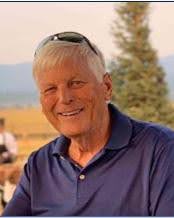 Mike Iverson passed away on August 12, 2024, after battling pancreatic cancer for many years. He was surrounded by his family and friends.
Mike Iverson passed away on August 12, 2024, after battling pancreatic cancer for many years. He was surrounded by his family and friends.
Mike was born in Oakland, California. He earned his Eagle Scout Award, an accomplishment he truly valued. After graduating from Central Valley High School, he went on to study at UC Davis where he earned his Bachelor of Science and Master of Science degrees, both in Civil Engineering.
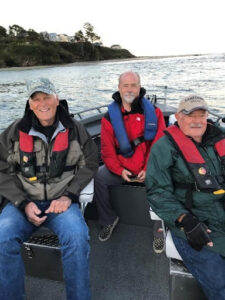 Mike worked for 45 years at CH2M HILL as one of the company’s most capable and accomplished project managers. He managed complex projects around the world, from Abu Dhabi to Singapore. He enjoyed the travel and new experiences that came with these projects, but the people he met, and the friendships made with colleagues mattered most. Mike was well respected at CH2M HILL. The following picture shows him enjoying salmon fishing in Oregon with John Filbert and Bob Kemmerle.
Mike worked for 45 years at CH2M HILL as one of the company’s most capable and accomplished project managers. He managed complex projects around the world, from Abu Dhabi to Singapore. He enjoyed the travel and new experiences that came with these projects, but the people he met, and the friendships made with colleagues mattered most. Mike was well respected at CH2M HILL. The following picture shows him enjoying salmon fishing in Oregon with John Filbert and Bob Kemmerle.
It was at UC Davis that Mike met Caralee Dean. After graduating from college, they were married in the Bay Area and soon thereafter had two kids and moved to their forever home in Alamo, California. Together they loved to go on adventures near and far—hiking, river rafting, touring museums in Europe, and snorkeling in Hawaii. Their favorite times were spending summers at Lake Almanor and going fly fishing in Montana. In 2023, Mike and Cara celebrated their 50-year wedding anniversary.
Mike was actively involved in his children’s and grandchildren’s lives. He loved watching their sports games, going on donut runs, pulling them on tubes behind the boat, and spending quiet moments reading books and watching movies. He loved his family.
Mike was a member of Community Presbyterian Church (CPC) in Danville for over 40 years. He was a Christian, who lived out his faith by serving others. He served as a CPC Deacon and Elder, was a member of the CPC Missions Committee, and volunteered for many years at the World Impact and City Team in Oakland, California. He was able to use his engineering knowledge and experience to help CPC bring water to a rural village in Ethiopia; this was a joy project for him, and the village continues to thrive today.
Dick Ivey
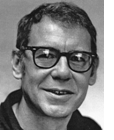
Born in Portland, Oregon, in 1928, Dick Ivey attended Reed College where he graduated with a B.A. Degree in History (1950). He completed his Masters Degree in Political Science at UC Berkeley in 1957. Following his undergraduate work, he served in the U.S. Army from 1950 to 1954. After his military service, he returned to graduate school and worked as an editor and reporter for the Port Angeles, WA, Evening News from 1954 to 1956. He was also a researcher at the Bureau of Governmental Research and Service at the University of Oregon.
Dick joined CH2M in 1964 to establish the firm’s planning practice and served as its Vice President and Discipline Director for Planning. He was a major architect of the Portland, Oregon, Downtown Plan in the early 1970s, and was recognized by Oregon Governor Neil Goldschmidt as the “father of the Portland downtown transit mall.” He was also recognized by Lloyd Anderson, a former Portland City Commissioner and who hired Dick at CH2M: “He had a genius for figuring out how to translate ideas into workable public policy.”
As an extension of the Planning Discipline, Dick established the firm’s environmental planning practice in the early 1970s, which ultimately led to the management of large interdisciplinary environmental projects. He helped manage international assignments in Saudi Arabia and worked with the Navajo and Hopi Indian Tribes’ relocation programs in the 1980s. Dick developed strong and enduring client relationships by becoming a friend and respected colleague. Clients around the nation would inquire about him when meeting with other CH2M HILL staff, even years after their encounter with Dick. His sense of humor and open, honest, friendly style accounted for the respect many of his clients had for him.
Dick was a visionary and believed in the value of helping clients solve a problem through creative thinking and planning, and clients responded accordingly. In the early years, this began to differentiate the firm from its competition. Later, others saw the value and copied the practice by offering interdisciplinary, comprehensive services themselves. He established a high standard of excellence, especially in communication and in written products. His staff considered him more of a father or colleague than a boss. He was long on guidance, and a tough but constructive critic. He was careful to develop the planning discipline as a collaborative. His creative thinking, alternative viewpoints, and practice on the periphery of engineering, which he sometimes viewed as too linear, made him a maverick legend in the firm.
He was a member of the American Planning Association and a Board member of the American Research Center in Egypt. In 1992, he received the Rudi Bruner Award for Urban Excellence for technical work contributions to the development of Portland’s 1972 Downtown Plan.
Dick retired from CH2M HILL in 1994, and died in August 1996. In addition to his own personal accomplishments in the firm, his most valuable contribution was to help broaden the company perspective, and thereby the depth, breadth, and effectiveness of services provided.
Robert “Bob” Jacobs

Born in San Mateo, California, in 1945, Bob Jacobs attended the University of San Francisco for 2 years. He transferred to the University of California at Berkeley and received a B.S. Degree in Civil Engineering in 1967. He received a Masters in Transportation Engineering from UC Berkeley the following year.
Bob was drafted in 1969 and completed U.S. Army basic and advanced basic training. He applied for Officer’s Candidate School and after graduation worked with the U.S. Army Corps of Engineers (USACE) in Vietnam, where he earned a Bronze Star for his service.
Following his USACE service, he joined the Portland office where he worked for Les Wierson. Bob soon moved to the Denver office in 1972 as their first transportation engineer. Following his Denver assignment, Bob was recruited as one of the pioneers of CH2M HILL International when he was assigned to the Dammam, Saudi Arabia, office, the first long-term overseas office. Bob arrived in Dammam mid-year 1978 and served as the project team Traffic Engineer to develop a master plan for the Dammam-Al Khobar-Dhahran metropolitan area. When the project finished in the spring of 1981, Bob transferred to the Seattle office.
Bob soon returned to Saudi Arabia in the fall of 1982 to negotiate the contract for and serve as the unofficial “team leader” for the development of a master plan for the City of Hail and the surrounding Hail Province. Bob functioned as the technical coordinator in charge of all technical matters and quality control, including client contracts and deliverables. Bob left in the fall of 1984 when the project was completed. Bob returned to Saudi Arabia again in late 1985 to finalize the scope of work for the development of the Riyadh metropolitan area master plan. Bob was again the technical coordinator. He left in the summer of 1987, traveled to Thailand, and married his wife, Apple.
Bob and Apple returned to the U.S. in 1988. After a honeymoon tour of the U.S., they settled in Southern California where Bob accepted a position in the Santa Ana (SCO) office. During his tenure in SCO, Bob managed several major environmental and hazardous waste remediation programs.
Bob announced his retirement in 2008 after 38 years of service. During retirement, Bob spent time with family, helping his sons with their academics and activities. Outside of that, Bob could be found solving numerous crossword puzzles and deciphering complex mind games on the kitchen patio. Bob was known for his laissez-faire approach to life and his unconventional, witty sense of humor. A lot of his humor was extracted into stories, which would typically involve statistics, politics, and family flaws mixed with mild sarcasm. All around, Bob was loved by everybody and would commonly integrate a mundane event into mounds of smiles and laughter. Bob passed away on October 15, 2012, in Orange, California. Read More…
Warren W. Jacobs
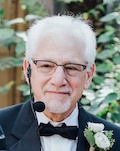
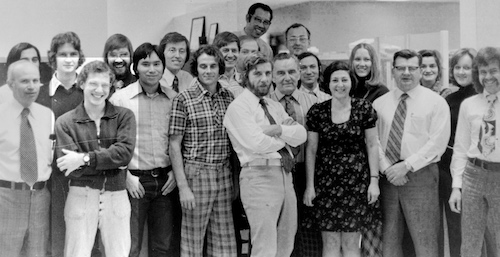
Wastewater and Water Designers, 1972
Warren Jacobs was born and raised in Toronto, Canada, in 1949. He attended the University of Toronto where he received his Bachelor of Applied Science (B.A.Sc.) Degree in Civil Engineering in 1972.
Following graduation, Warren joined Gore & Storrie Consulting Engineers (G&S) in Toronto, 6 years before CH2M HILL established its first office in Canada. His first assignment found him on the drafting board laying out pumps and piping for a wastewater treatment plant (WWTP) primary settling tank gallery. Six months into employment, he received a tap on the shoulder, literally. He was being “voluntold” for a posting as the lone resident engineer at a greenfield water treatment plant (WTP) and reservoir for the small remote whistle stop of Fauquier in Northern Ontario. Warren was single at the time and immediately accepted. The butterflies set in that night. He had absolutely no prior field experience, and he was to be responsible for inspection of all trades. Relief came the next day at work in the form of 50 photo-copied pages of a variety of disciplines, sort of a predecessor of Resident Engineer for Dummies. Fast forward – very successful construction job. This first-hand field experience would help Warren over his multi-discipline design career.
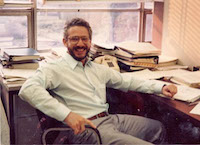
After the completion of the Fauquier assignment, Warren returned to Toronto and began designing process mechanical systems for the proprietary thermal oxidation Zimpro System. The project’s requirement for a computer system led Warren to design, specify, and test a SCADA system.
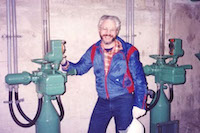 Later in the 1980s, Warren and two other engineers received an additional “hat” to wear, that of a support team for the first in-house telephone PABX system and in-house super-minicomputer system. A couple years later, some IT graduates were hired; and we engineers passed the “IT baton” to our first real IT team who wore only one “hat” and would not be distracted with design deliverables looming.
Later in the 1980s, Warren and two other engineers received an additional “hat” to wear, that of a support team for the first in-house telephone PABX system and in-house super-minicomputer system. A couple years later, some IT graduates were hired; and we engineers passed the “IT baton” to our first real IT team who wore only one “hat” and would not be distracted with design deliverables looming.
In the early 1990s, Warren and two other engineers changed hats as they became charter members forming Toronto’s Instrumentation & Control (I&C) Department.
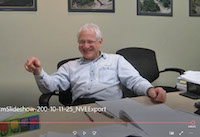 During these hectic and competitive times, G&S agreed to merge with CH2M HILL in 1995. The Canadian offices began operating under the moniker CG&S (CH2M Gore & Storrie) before changing to CH2M Canada a few years later. From that point, Warren designed projects for Canada and the U.S.
During these hectic and competitive times, G&S agreed to merge with CH2M HILL in 1995. The Canadian offices began operating under the moniker CG&S (CH2M Gore & Storrie) before changing to CH2M Canada a few years later. From that point, Warren designed projects for Canada and the U.S.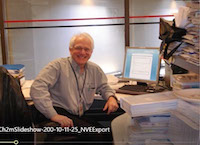
Warren continued to leverage his skills with the training of design staff on the use of process and instrumentation diagrams (P&IDs).
Warren likes to reflect on the simpler life of the early 70s. No fax, computer, or cell phone. He shares an example of the Fauquier project. He needed a boat to survey the installed location of the raw water intake structure. The nearest boat rental store was far away. To save some expense, since he already had the requisite trailer hitch, he offered a local resident to rent his boat for a case of beer. Not a problem. Later, when submitting his expense claim, it clearly showed “boat rental” complete with attached cash register receipt from the beer store. Reimbursement came through successfully.

Race to the Sun, Montana
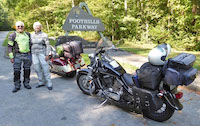
Tennessee
Warren announced in February 2016 after 44 years that he would retire in the fall of the year. He shares that it was easy to remain at one firm for 44 years when surrounded by such talented and friendly people. He’ll forever cherish memories of interesting technical design projects; the fun job-site startup and commissioning; but, more importantly, the extra-curricular activities that staff participated in.
Warren and Karen, his wife of 44 years, have two grown children living in the Toronto area and a third living in Seattle, WA. Warren and Karen look forward to continuing their enjoyment of road trips on their motorcycles that have carried them to the Rockies, San Antonio, east coast, and Tennessee. When COVID-19 is behind us, they want to ride from Toronto to Seattle, WA, for a stay with their daughter and her family, and include a ride along U.S. Route 101.
Life is good!

Annual CH2M Dinner Dance
Richard L. (Dick) Jacobson
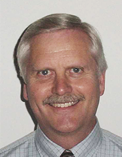
Richard L. (Dick) Jacobson was born in Sioux City, Iowa, in 1950. He graduated from Iowa State University in 1972, where he received his B.S. Degree in Civil Engineering.
Dick worked for the City of Ankeny, Iowa, from June 1972 through October 1978 in the Engineering, Building, and Zoning Department. After receiving his Professional Engineering license in Iowa, Dick and his wife, Julie, decided to seek opportunities out west; and Dick accepted a position with HKM Associates in Billings, Montana, where he worked from November 1978 until March 1989. While at HKM, Dick was involved in project management, design, and business development and was later selected as Director of Highways and Urban Transportation Projects.
Dick and Julie loved Montana and said they would never leave. That is, until Dick was recruited to join CH2M HILL. The firm’s reputation and the prospect of exciting opportunities eventually won him over. He joined CH2M HILL in March 1989 in Fresno, California (FRS), as a senior project manager, where Dick had the opportunity to work on some large freeway projects for the Fresno County Transportation Authority (FCTA), as well as other municipal projects. In June 1994, Dick transferred to the Boise, Idaho, office (BOI), where he worked in various capacities in the Transportation Business Group (TBG) including senior project management, business development, project delivery, and staff management. Dick was also a mentor to several staff over the years, leading by example, and building successful project teams with a focus on client service.
In 2005, CH2M HILL and Washington Group International formed a joint venture to successfully pursue a program management contract with the Idaho Transportation Department (ITD). The $1 billion ITD Grant Anticipation Revenue Vehicle (GARVEE) Transportation Program was the largest infrastructure program in Idaho history. Dick served as the Deputy Program Manager, responsible for overseeing project development and quality control. The Program, consisting of 59 projects in six major highway corridors, was delivered safely, on time, and under budget.
Dick was active in professional societies throughout his career, including the American Council of Engineering Companies (ACEC), the Institute of Transportation Engineers (ITE), and the American Society of Civil Engineers (ASCE). He served as president of the Intermountain Section ITE in 1989, president of the Central California Section ITE in 1994, and president of ACEC of Idaho in 2005. In 2014, Dick was honored with life membership in ACEC. He is also a life member in ITE and ASCE. Dick also participated in the Treasure Valley Chapter of the Women’s Transportation Seminar (WTS) and was awarded a 2014 WTS Lifetime Achievement Award by the Chapter.
Dick retired in December 2014 after 42 years in the profession, including 25 years with CH2M HILL. He and Julie continue to live in Meridian, Idaho, and are blessed to have both of their children and all five of their grandchildren also living in the area. Dick enjoys family times with the kids and grandkids, as well as camping, fishing, traveling, and working on minor remodeling projects around the house and yard.
Frank Jenes
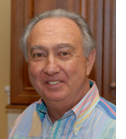
Born In Hoquiam, Washington, in 1938, Frank Jenes attended the University of Washington and received his B.S. Degree in Civil Engineering in 1961. After college, Frank worked for the California Division of Highways (now Caltrans) in Los Angeles, CA; Quentin Engineers, Ltd., Los Angeles; Sverdrup & Parcel, Bellevue, WA; and the Port of Seattle, WA, where he served as Engineering Manager for the SEA-TAC Airport expansion program from 1969 to 1972.
Frank joined CH2M HILL in 1972 where he worked on several major projects in offices in Bellevue, WA; Milwaukee, WI; St. Louis, MO; and Santa Ana, CA. Significant responsibilities included Deputy Program Director on the Milwaukee Water Pollution Abatement Program; Program Director for the St. Louis, MO, Water Pollution Abatement Program; Corridor Design Manager on the 26-mile Eastern Transportation Corridor design-build toll road in Orange County, CA; and Design Operations Manager for the 18-mile Foothill Transportation Corridor design-build toll road in Orange County, CA.
Frank was very active in professional societies holding many offices in the Seattle Section of the American Society of Civil Engineers (ASCE), President of the Seattle Engineers Club, Founder and President of the Puget Sound Chapter of the Project Management Institute (PMI), and Region III National Vice President of PMI. Throughout his career, Frank received many honors and awards for his contributions to ACSE, the American Society of Mechanical Engineers (ASME), and PMI.
Frank retired in 2000 and now enjoys cooking and traveling to the four corners of the world.
Jim Jodie
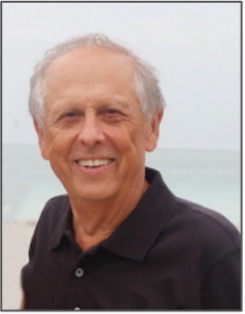 Jim Jodie was born on September 24, 1940, in Cadott, Wisconsin (Chippewa County). He was raised on the Jodie farm until he was 17, when he moved to the University of Wisconsin-Madison. There he became a Civil Engineer majoring in sewer design, transportation, and environmental projects. He was also a member of Triangle Fraternity.
Jim Jodie was born on September 24, 1940, in Cadott, Wisconsin (Chippewa County). He was raised on the Jodie farm until he was 17, when he moved to the University of Wisconsin-Madison. There he became a Civil Engineer majoring in sewer design, transportation, and environmental projects. He was also a member of Triangle Fraternity.
Jim and his wife, Angelina Zammuto Jodie, married in 1965. He loved to travel around the world with Angie, including staying in Puerto Vallarta for 25+ years in the winter, and sailing in the British Virgin Islands with close friends, along with several trips visiting Angie’s family in Sicily and elsewhere in Europe. He also enjoyed visiting relatives in Cadott and Rockford, Illinois. The children continue the tradition of learning about other people throughout the world.
Jim volunteered tirelessly with Angie at Catholic Marriage Preparation classes, with the Alexander Graham Bell Association for the Deaf, and as Assessors at Alverno College. He was a devoted member of Christ King Church and St. Mary’s in Elm Grove.
Jim was also passionate about and volunteered in local government and politics. During his years in Civil Engineering, he worked for the City of Milwaukee, the State of Wisconsin, Jack Leisch, Inc., and CH2M HILL (in West Palm Beach, Boise, and Chicago).
In his retirement, Jim enjoyed volunteering in STEM (Science, Technology, Engineering, and Math) in the School District of Waukesha and with the Elm Grove Plan Commission. His favorite hobbies were going to the symphony and plays with his wife, spending time with his children, grandchildren, friends, and relatives, and taking walks with his buddies. He spent numerous hours photo-journaling, which his family will continue to treasure.
After a brave 16-month battle with pancreatic cancer, Jim passed away on Sept. 1, 2021 at the age of 80 at his home in Elm Grove, Wisconsin.
Bruce A. Johnson
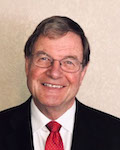 Born in Salt Lake City, UT, in 1947, Bruce Johnson went on to attend Brigham Young University where he earned a Bachelor of Engineering Science (BES) Degree in Chemical Engineering in 1971. Upon graduation, he joined the Commissioned Officer Corps of the U.S. Public Health Service where he served in coal miner safety and helped establish the Appalachian Center for Occupational Safety and Health in Morgantown, WV.
Born in Salt Lake City, UT, in 1947, Bruce Johnson went on to attend Brigham Young University where he earned a Bachelor of Engineering Science (BES) Degree in Chemical Engineering in 1971. Upon graduation, he joined the Commissioned Officer Corps of the U.S. Public Health Service where he served in coal miner safety and helped establish the Appalachian Center for Occupational Safety and Health in Morgantown, WV.
Upon completion of service, he returned to college and obtained his M.S. and PhD Degrees in Civil and Environmental Engineering from Utah State University. When the Teton Dam collapsed in 1976, he joined an engineering firm that was engaged in repairing and upgrading water and wastewater systems in Eastern Idaho.
Bruce joined CH2M HILL in 1979 in the Boise office where he managed several water and wastewater projects throughout Idaho, including the development of several industrial pretreatment programs. He also managed a salinity control study of two tributaries of the Colorado River for the U.S. Bureau of Reclamation (USBR) and the Jordan River Flood Control Project for Salt Lake County in Utah.
In 1985, Bruce moved to Key West, FL, to head up an office to provide services in the Florida Keys. Major projects for the City of Key West included the first wastewater treatment plant for the City, improvements to the wastewater collection system, and a variety of recreational facility projects. Additional projects for the Florida Keys Aqueduct Authority included improvements to the water treatment facility in Florida City, transmission main and pumping station improvements, and investigation of additional water storage options.
In 1987, he moved to the newly-opened Boston Office to head up a Safe Drinking Water Act Compliance Study for the Massachusetts Water Resources Authority. This project led to an extensive pilot treatment project and the design and construction of treatment facilities for controlling corrosion of lead and copper in the distribution system. The pilot treatment project was awarded the ACEC Grand Conceptor Award for New England. Other projects included participation in value engineering studies for the Boston Harbor Cleanup project, CSO studies in Maine, and a water treatment plant in Connecticut. Bruce also supported a variety of projects in Detroit (primarily lead and copper control in drinking water) and spent a year in Louisville, KY, developing a master plan for the Louisville Water Company. He also served as water and wastewater discipline director for the Northeast District.
In 1996, Bruce moved to the Las Vegas office where he managed a variety of water and wastewater treatment projects for the City of Henderson, City of Las Vegas, Clark County Water Reclamation District, Las Vegas Valley Water District, and Southern Nevada Water Authority. Projects included design and construction of solids dewatering facilities, pump stations, water treatment plant improvements, design of a grass roots wastewater treatment facility, disinfection by-product control pilot studies, and a landfill closure. He also provided management of several projects for the USBR Yuma, AZ, Desalting Facility.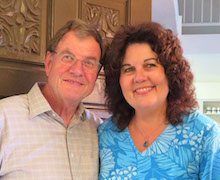
Bruce was also active in professional societies including president of the Nevada Water Environment Association and on the Board of the Western Coalition of Arid States. He also served on the Clark County Air Quality Hearing Board for 12 years.
After nearly 36 years, Bruce retired in 2014. He then became involved in the local school district’s Payback program, which focuses on encouraging at-risk students to stay in school. He also judged robotics competitions and coached a robotics team. This eventually led to a full-time position teaching science at a private school. Currently (2020), Bruce and his wife, Marcia, are serving a 2-year mission for their church in Kona, HI. He and Marcia have four children and nine grandchildren. Their interests include spending time with family and friends, helping where they can, and a little travel.
Paul Johnson
 Paul Johnson was born in 1958 in Phoenix, Arizona. He attended Arizona State University where he earned his Bachelor of Science Degree in Construction Engineering Management in 1980. Following graduation, he went to work for a construction management firm based in Phoenix where he earned his wings in estimating, scheduling, and project field engineering assignments on schools and prison projects in Phoenix, Sacramento, and Albany, OR.
Paul Johnson was born in 1958 in Phoenix, Arizona. He attended Arizona State University where he earned his Bachelor of Science Degree in Construction Engineering Management in 1980. Following graduation, he went to work for a construction management firm based in Phoenix where he earned his wings in estimating, scheduling, and project field engineering assignments on schools and prison projects in Phoenix, Sacramento, and Albany, OR.
Paul joined the firm in the Seattle office in November 1987, where he served as a Value Engineering (VE) facilitator and site selection manager for new schools projects in Western Washington.
In 1992, Paul transferred to the Boise office and branched out in VE studies for transportation, water/wastewater, and other projects across the U.S. and Canada. He managed several projects as a third-party construction manager (CM) from the start of planning through design and construction. Projects included a courthouse, numerous detention facilities, a public safety academy in Oregon, and a hospital expansion. He also spent 2 years in Qatar as part of the firm’s program management team. He led a staff of logistics professionals in developing numerous initiatives to help Qatar’s Supreme Committee for Delivery and Legacy prepare transportation, utility, and stadium/precinct infrastructure for the 2022 World Cup.
As a Certified Value Specialist (CVS), Paul has led approximately 275 VE studies. He shares that he had the best job at the firm because leading VE studies allowed him to work on all of the firm’s major project types across the U.S. and Canada and even the Middle East. He worked with hundreds of our professionals from all disciplines, bringing significant value to our clients in the form of cost savings without compromising the functional requirements of our projects.
Paul joined HDR in Honolulu in July 2017 to be the full-time Director of Risk Management on the $8 billion Honolulu Rail Transit program. He transferred back to Boise in January 2020 where he continues to support the Honolulu program. He is also leading VE and Risk Assessments for HDR’s clients across the U.S.
While he took on this new role with HDR, he is proud to be a CH2M alum and extends his deepest appreciation to all alumni and (now Jacobs) employees, colleagues, and clients, for the many opportunities and rewarding experiences he had with the firm over 30 years! He attributes this success to several distinguished alumni including Mike Doleac, Don Ulrich, and our late colleague Gary Morgan.
Mike Jury
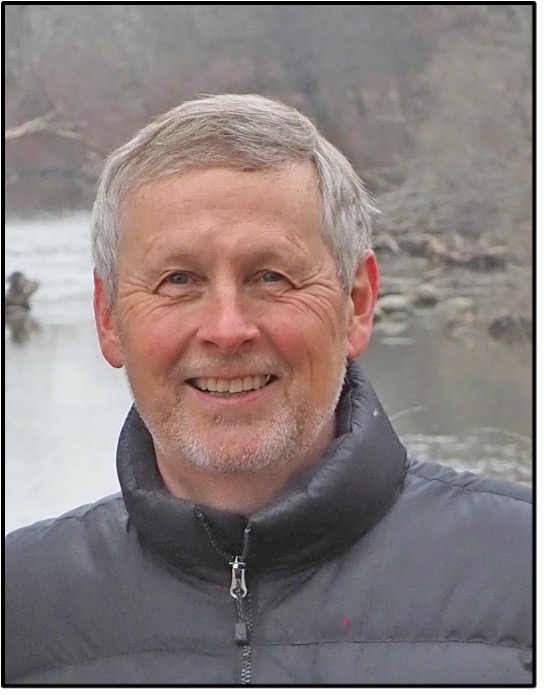 Mike Jury was born in Seattle in 1951; and, after a few years in Richland, WA, he was raised in the Seattle area. Mike graduated from the University of Washington with his B.S. Civil Engineering degree in 1973 and worked as a lab tech in the CH2M HILL Bellevue, WA, office’s wet chemistry lab during the following summer. He then began graduate school at the Univ. of Wash. with the financial help of a U.S.EPA traineeship. After completing his coursework and working part-time, Mike began working full-time at CH2M HILL’s Bellevue office in 1975 and graduated with his M.S. Civil Engineering (Environmental) in 1980.
Mike Jury was born in Seattle in 1951; and, after a few years in Richland, WA, he was raised in the Seattle area. Mike graduated from the University of Washington with his B.S. Civil Engineering degree in 1973 and worked as a lab tech in the CH2M HILL Bellevue, WA, office’s wet chemistry lab during the following summer. He then began graduate school at the Univ. of Wash. with the financial help of a U.S.EPA traineeship. After completing his coursework and working part-time, Mike began working full-time at CH2M HILL’s Bellevue office in 1975 and graduated with his M.S. Civil Engineering (Environmental) in 1980.
Mike initially began his engineering career working on municipal wastewater final design and facilities planning projects. His focus changed when he worked for project manager Craig Zeien on the zero-discharge treatment and water softening facilities for the City of Colorado Springs R.D. Nixon Power Plant. Mike was project engineer for the preliminary and final designs and operations manual and was resident engineer during construction and facility startup. The experiences Mike had as a resident engineer (under Terry Sheldon’s onsite direction) along with his other roles on this complex industrial-type water and wastewater project were invaluable assets his entire career.
Mike was assigned to the industrial water/wastewater discipline after returning to the Bellevue office. Mike managed process and final designs of water and wastewater systems in several industries (including electric power, pulp and paper, automotive, and primary metals).
In early 1983, he raised his hand to work on the rapidly expanding number of hazardous waste management projects under CH2M HILL’s CERCLA (Superfund) REM/FIT contract. Later in 1983, he volunteered again to move to Milwaukee to program manage the REM/FIT projects for U.S. EPA’s Region 5 with Mike Harris. What was supposed to be a 4-year stint in Milwaukee turned into a permanent relocation when he and his family volunteered to stay in Milwaukee, where he finished his career.
Mike was program manager of CH2M HILL’s projects in U.S. EPA Region 5 (REM/FIT, REM IV, and ARCS V). He directed remedial investigations, feasibility studies, remedial designs, and remedial actions at more than 40 National Priority List sites. The highlight of his Superfund program management experience was working with project teams and the firm to develop the means and methods to deliver high quality hazardous waste management projects. These efforts played a significant role in growing CH2M HILL’s hazardous waste management business from a small player to a major business within CH2M HILL and an internationally recognized leader in the field.
As part of CH2M HILL’s management, Mike was a district discipline director for the firm’s industrial water/wastewater/hazardous waste discipline and a regional environmental business group manager.
In 1998, Mike was contacted by an attorney he had previously worked with to assist a client with potential liability on a PCB-contaminated sediment site in Wisconsin. The project grew into one of CH2M HILL’s first major contaminated sediment management projects. Mike became project manager and/or project coordinator of multiple Lower Fox River CERCLA projects for WTM I Company (f/k/a Wisconsin Tissue Mills), including contaminated sediment investigation, remediation, and litigation support. During the last several years of Mike’s career, he served as senior technical consultant for contaminated sediment management projects throughout the U.S.
After retiring in 2013, Mike was subcontracted back to the firm through HKA. He fully retired in 2016 after WTM I Company’s liabilities on the Lower Fox River were successfully closed out.
Three projects Mike either managed or worked on as a project engineer received American Council of Engineering Companies (ACEC) awards: 1) National ACEC Engineering Excellence Honor Award for Wausau Paper Mills’ sulfur dioxide control system (project manager); 2) Wisconsin ACEC Engineering Excellence Honor Award for zero-discharge contact cooling water systems process design for Alcoa’s Deschambault, Quebec primary aluminum smelter (project manager); and 3) National ACEC Engineering Excellence Honor Award for the City of Colorado Springs R. D. Nixon Power Plant’s zero-discharge and water softening facilities (project and resident engineer).
As Mike reflected on his CH2M HILL career, “What stands out are the amazing quality people I worked with, the variety of interesting projects I worked on, and the access I had to the organization’s incredible resources to deliver great projects. Over my career, I learned how special this was and how fortunate I was.”
Mike always thought he would volunteer for some environmental cause when he retired and is doing just that with Citizens’ Climate Lobby. He and his partner, Patty Walker, are both retired living in Delafield, WI, when they’re not at his Door County, WI, house on Lake Michigan. Mike’s two kids (with late wife Laurie) and Patty’s two kids and their families (total of 10 grandkids) live in the Milwaukee area. So, there’s a lot of ongoing grandparenting. Other fun stuff includes biking, kayaking, hiking, and traveling.
Mike can be contacted at 414-915-3415 mjury@sbcglobal.net or mjury331@gmail.com.
Carol Kangas
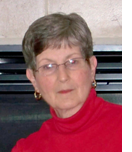
Born in Milwaukee, Wisconsin, in 1944, Carol Kangas attended Milton College and the University of Wisconsin-Milwaukee majoring in math. After 1.5 years, she left school to marry Jim Kangas in 1964. Carol spent the next 17 years working for several companies in various secretarial and administrative positions, the last of which was for the accounting firm of Arthur Young & Co. in the area of mergers and acquisitions. In 1975, she returned to college part time and graduated from Carroll College in Waukesha, Wisconsin, with a B.S. Degree in Business Administration in 1982.
Carol joined CH2M HILL in 1980 in the Great Lakes Regional Office as the Office Services Supervisor. In 1984, she was promoted to the Regional Administration Manager for the Great Lakes Region. One of the highlights of this position was the purchase of the first voice mail system for the firm – real cutting edge technology at the time. Carol moved to Denver as the Central District Administrative Manager in 1991. The first of many reorganizations in 1993 saw her becoming the Regional Business Manager for the then Rocky Mountain Region. In 1994, she joined the corporate staff in Denver as the Corporate Administrative Manager; and, in 1996, she added duties supporting the Regional Operations Group. Carol’s final position began in late 1997 when she moved to Atlanta as the Southeast Regional Business Manager.
Carol retired in August 2001 and remained in Atlanta until 2003 when she and Jim moved to Mesa, Arizona. Since retiring, she has become a quilter and is active in the Arizona Quilters Guild. Each February 1 to April 15, she also volunteers as a tax aide with American Association of Retired Persons (AARP) doing taxes for low to middle income seniors. In 2008, she also became local coordinator for the Mesa tax site. Carol recently joined the Mesa Branch of the American Association of University Women and participates in several of their committees. Carol and Jim also enjoy hosting friends and former CH2M HILL retirees, and just relaxing in their swimming pool.
Michael D. Kennedy
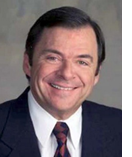
Michael Douglas Kennedy, Mike, was born in 1949 in Colfax, Washington, where his parents were both students at Washington State College. After growing up in Western Washington, Mike graduated from the University of Washington in Seattle in 1971 with a B.S. Degree in Civil Engineering. He was hired in June of that year into CH2M’s Portland office by Les Wierson. Mike worked on the Clackamas County Sewerage District Number 1 project for several years and then was fortunate to be assigned to work on the COR-MET joint venture program to design a solid waste management system for the Portland region. Mike worked on this program for almost 6 years, working his way up to become Program Manager. This program began a career-long involvement with waste management planning and design. He was a founding member of the Solid Waste Discipline, and worked around the U.S. and overseas on a variety of waste management projects.
In 1984, when the firm founded the Industrial Design Corporation (IDC) from staff in the Industrial Division of the Portland Office, Mike was selected to be the Division Manager of the staff left behind. In 1987, he was selected to become the Portland Regional Manager, replacing Dann Madden. He served in this role until 1992, leading the Portland Office on a sustained growth trajectory, increasing staff from under 100 to over 250.
In 1992, with the firm suffering from a declining backlog, Tom Gibbs and Les Wierson asked Mike to serve on a new Corporate Marketing and Sales team, led by Bob Card. The new team included long-time staff Jacque Crenqa (now CEO Jacque Hinman), Greg McIntyre, Willie Loud, and Tom Cutting. The team’s mission was to change the firm’s culture around marketing and sales; but over the next year, it became apparent that the firm needed more change than a small Corporate team could produce. In the summer of 1993, Bob Card, Greg McIntyre, and Mike all became a part of the firm’s “Re-Engineering” process team. This process led to the most fundamental changes to the firm since its founding.
As a result of the re-engineering, Mike was asked to move to Seattle and become the Manager of the new North Pacific Region, encompassing the offices in Corvallis, Portland, Seattle, Boise, Anchorage, and Honolulu. While in this role, he was also asked to serve on the firm’s Board of Directors, which he did for three consecutive terms.
In 1997, long-time employee Craig Zeien, serving as the firm’s Regional Operations President, tragically succumbed to brain cancer. Ralph Peterson, CEO, called on Mike to fill the role and serve on the firm’s Executive Leadership Team (ELT). In this role, he was responsible for the operations of all the firm’s 200+ North American offices. He also oversaw the firm’s Health, Safety, and Environment program and staff; the firm’s Governmental Affairs operation in Washington, D.C.; and the Corporate Communications and Marketing Group. While in this role, Mike led a number of initiatives that improved the firm’s overall functioning and effectiveness. A new office security program and employee ID card program were implemented worldwide. An Intellectual Property program was put in place to help the firm profit from inventions created by employees. A Management Consulting group was started; and the firm’s first annual Sustainability Report was created, tracking the firm’s impact on our environment. Mike also continued his efforts to create a diverse and inclusive environment in the firm, creating the Office of Minority Affairs in the HR group.
Mike also was active in the firm’s internal training programs and, with Bud Ahearn, was the Executive Sponsor for the Leadership Development Program held at the University of Michigan. This highly successful program paired ELT members with staff from the University’s Executive Development program to teach young leaders about the culture of the firm. Partly as a result of teaching in this program, Mike recognized his need for some additional personal development. Ralph Peterson agreed, and the firm sent Mike to the Harvard Advanced Management Program (AMP) in the spring of 2003. When Mike returned to the firm, Ralph asked him to replace Bud Ahearn as President of the Transportation Business Group.
Over the next 5-1/2 years, Mike led the group to a number of new successes, growing the group by over 2-1/2 times and establishing the firm as a top five player in the transportation industry. The TBG won and completed a number of significant projects during this time, including the program management of the Mumbai, India, international airport expansion; the design and construction of the $875 million Golden Ears Suspension Bridge in Vancouver, B.C.; the Crossrail Program in London; and the Sea to Sky highway expansion in conjunction with the Vancouver Olympics. In 2007, TBG leadership agreed to a strategy of becoming the world’s most recognized Program Manager and set out to capture the program for the Expansion of the Panama Canal. Mike served as Executive Sponsor and led the team to win the program in 2008. This internationally recognized icon program firmly established TBG and CH2M HILL as a global powerhouse in Program Management.
In late 2008, the firm’s CEO, Lee McIntyre, asked Mike to relocate to Panama and take over as the Global Program Manager for the Panama Canal Expansion. Mike and Suzanne moved to Panama City in early 2009, and Mike led the team through the preparation of bid documents and evaluation and award of the major locks design-build contract. In 2010, Mike contracted some as yet unidentifiable disease in both ears, causing him to completely lose all hearing. He and Suzanne returned to the U.S. for successful reconstructive surgeries on both ears, and Mike retired in November of 2010 after 40 years of service.
Throughout his career, Mike was known for his collaborative work style, dedication to mentoring, attention to client service, innovation, and overall good humor. When Mike was hired in 1971, the firm had about 450 employees. When he retired in 2010, the firm had over 25,000 employees. Mike was proud to have been one of the many leaders at CH2M HILL who created today’s great company.
Anne Kernkamp

Anne Kernkamp was born in Detroit, Michigan, in 1953. She attended Michigan State University on a National Merit Scholarship. During college, she was fortunate to intern at the MI Department of State Highways and Transportation, Exxon in New Jersey, and Argonne National Laboratory in Chicago. In 1975, she graduated from the Honors College with a B.S. Degree in Civil Engineering, then an M.S. Degree in Civil Engineering in 1977. Upon graduation, Anne joined CH2M HILL in the Wastewater Reuse Department in Corvallis, Oregon.
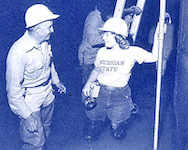
After a year in Corvallis, Anne transferred to San Diego where she had the amazing experience of working directly with founder Jim Howland on the San Diego Metro Wastewater Program, one of the firm’s first wastewater programs. The mission was to upgrade the City’s sole wastewater treatment plant from primary to secondary treatment. They managed to work themselves out of a job by successfully obtaining an EPA waiver from secondary treatment. After a stint in Virginia, she transferred to San Francisco.
San Francisco returned Anne to her first love of wastewater reuse and resource recovery. For the next 25 years, she would work with the City of Santa Rosa on agricultural, industrial, and urban reuse, and also with the East Bay Municipal Utility District (EBMUD) on industrial water reuse. The Santa Rosa program was particularly remarkable for the Geysers Recharge Project. During most years, the entire wastewater flow from the City is pumped to the Geysers geothermal field, where it is injected then extracted as steam to run turbines for power generation. She also worked on projects for EBMUD to add ozone to three water treatment plants and a wastewater plant to treat and reuse water at a Chevron Refinery.
After marrying her EBMUD senior consultant and fellow employee Dana Rippon, they moved to Redding, California, where Anne managed the office before moving to Austin, Texas. In Austin, Anne helped bring the City’s three water treatment plants into compliance with the Safe Drinking Water Act. After completing the program, she and Dana returned to Redding where she worked on a variety of projects, including consulting for other business groups and international projects.
After retiring in 2014, they still call Redding home, where friends can visit them and the occasional peacock or at their log cabin in Southern Utah, where the buffalo roam out back safely behind a fence.

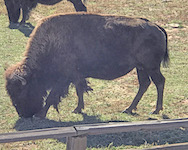
Myron King
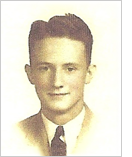
Myron King was born in Pender, Nebraska, in 1917. He acquired accounting skills through Correspondence School, Night Courses, and the International Accounting Society. He worked for 14 years as Chief Accountant for a manufacturing company in Sioux City, Iowa, prior to moving to Corvallis.
Myron joined CH2M in 1965 as the Chief Accountant. He headed the Accounting Department during the years when the firm made the transition from a Partnership to a Corporation. He moved from manual systems to an IBM punch card system, and finally to a fully computerized internal accounting system, working primarily under the supervision of Mike Fisher. He transferred to the Audit Department in the late 1970s, under the supervision of Vern Nelson.
Myron is one of the unsung heroes who contributed tenfold the time and energy needed to keep CH2M HILL vibrant, alert, and current in the Accounting Department.
Myron retired in January 1982, but continued to work on a part-time basis until the spring of 1995. Retirement activities included trying to outguess the Stock Market, gardening (flowers), and walking the dog. Myron passed away June 12, 2002.
Dale L. King
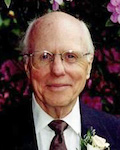
Dale King was born in Klamath Falls, Oregon, in 1927. He obtained a B.S. Degree in Civil Engineering from Oregon State College in 1949. Dale worked for the Oregon State Highway Department Bridge Design Section from June 1949 through February 1951.
Dale joined CH2M in March 1951 as a Structural Engineer, doing Structural Design work in an office he shared with Holly Cornell. Through the 1950s, he served as Project Manager on military projects for the U.S. Army Corps of Engineers, U.S. Air Force, and the U.S. Navy Bureau of Yards and Docks. Dale was also a major contributor to the successful execution of numerous projects at the Klamath Falls Airport, Mountain Home Air Force Base (AFB) in Idaho, the Moses Lake AFB, and two BOMARC Missile Sites, plus one at Malmstrom AFB in Montana.
In June 1968, Dale transferred to the Seattle office to serve as the Division Manager. From September 1984 through October 1987, Dale was in Alexandria, Egypt, to work on the massive Alexandria Sewerage project. From October 1987 through June 1990, he served as the Project Manager of the Water System Study and Design component of the Cairo, Egypt, Water Project. He returned to the SEA office in 1990.
Dale retired in 1992 to take up the life of many people who worked and played hard: play a little golf in between occasional health setbacks!
Dale passed away in March 2013.
Sue King
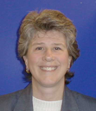
Born in Freeport, Illinois, in 1956, Sue King attended Western Illinois University (1976) and Montana State University where she received a B.S. Degree in Business-Accounting with highest honors and where she was elected to Phi Kappa Phi. Following graduation, Sue joined the accounting firm of KPMG.
Sue joined CH2M HILL in 1986 in the Portland office of the Industrial Design Corporation (IDC) and went on to serve as its Chief Financial Officer (1986-2004), and then as Senior Vice President of Operations for the firm’s Industrial Client Group (2005-2008). She also served on the Board of Directors from 1997 to 2007. During her career, Sue was a member of the Financial Executives Institute (FEI) and maintained her certification as a Certified Public Accountant.
Sue retired in 2008 with over 22 years with the firm. She currently resides in Oregon where she remains active consulting with Hamstreet & Associates and other firms and working on real estate projects. She serves on the Board of Directors for the Sherwood Young Men’s Christian Association (YMCA), the Board of Directors for Union Gospel Mission, and the Board of Advisors for Montana State University. She also enjoys her volunteer activities for the YMCA, Meals on Wheels, and various other organizations.
Pat Klampe
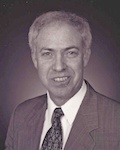
Pat Klampe was born in April 1945. He grew up on the family onion farm near Salem, Oregon. He graduated from Serra Catholic High School in 1963. Pat and Pam were married that September. Pat went to work for the Oregon Highway Department. After 5 years there, he recognized he needed a degree and to become registered to achieve his dream of being an engineer. With their two daughters, they relocated from Portland to Corvallis and Oregon State University. New freshman Pat started in January 1969 and graduated with a degree in Civil Engineering in the summer of 1972.
Pat started with the Corvallis office (CVO) of CH2M in August 1972 in the Civil Department, Discipline 14 (Transportation). For the next 15 years, he worked on a wide variety of great projects throughout the west. Most of this work was associated with design and project management on port facilities. Clients included the Port of Portland; Port of Los Angeles; Port of San Francisco; and the Oregon coast Ports of Coos Bay, Newport, and Astoria. Other projects included site development for the new Hewlett Packard campus in Corvallis and lead site civil engineer for the ASEA Team (from Sweden) to provide two 200-acre electrical converter stations for the Los Angeles Department of Water and Power’s new power feed from a coal-fired power plant in Utah to the Los Angeles metro area.
In September 1987, Pat and Pam relocated to Milwaukee (MKE) with their youngest daughter Nikole. From humble beginnings, the small civil-transportation group under Pat’s leadership began to develop a solid reputation for highway projects primarily with the Wisconsin Department of Transportation (DOT). Over the next 19 years, Pat served as project/program manager, division manager, and Northeast Regional Business Group Manager (RBGM) for this growing transportation group. They provided full-service professional capabilities and, from Milwaukee, moved staff and expanded into Illinois DOT, Illinois Tollway, O’Hare Airport, Missouri, Ohio, Iowa, Minnesota, Michigan, Virginia, District of Columbia, and Port of New York and New Jersey (aviation and port work). As leader of the Group, Pat was proud to be following the same plan as many successful CH2M HILL expansion stories: To hire and develop great people and then send them off to start new ventures, having strong ties back to their roots for support.
In 1997, Pat was selected to be the Great Lakes Regional Manager in MKE. Within 3 months, the firm had decided to re-organize to fewer regions. He then became the Transportation Regional Business Group Manager for the new NE Region. In 2005, Pat asked to step away from the RBGM position. He had always maintained project work along with the business administrative responsibilities, and he was ready for a change. The Region and the Transportation Business Group (TBG) selected Steve Wanders as his replacement.
In 2005 and 2006, Pat and Pam relocated to New Jersey as Pat opened and staffed the TBG sponsored office in New York City.
Late in 2006, Pat and Pam moved to Boise to be part of the management team for a $1 billion highway program for the Idaho Transportation Department. For 2-1/2 years, Pat enjoyed working with a great team of professionals that moved the program forward by pushing the “business as usual” envelope with effective tactics for better and faster highway project delivery.
Pat was registered as a Professional Engineer in many states. He was active in several professional transportation industry organizations including: Transportation Research Board (TRB), Transportation Committee of American Council of Engineering (ACEC), Wisconsin Transportation Builders Association (affiliate of American Road and Transportation Builders Association), and the Women’s Transportation Seminar (WTS).
In 2009, Pat and Pam retired to their ski cabin in Bend….and worked not a lick again. Since then, they have been busy keeping up with grandkids in Oregon, Arkansas, and the Boston area, while still getting in some fishing, skiing, biking, volunteering, and traveling to cool places.
Bill Knapp
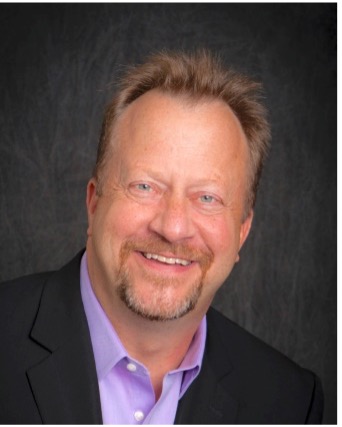 Bill Knapp was born on April 6, 1963, in Milwaukee, Wisconsin, and earned his BSCE from Purdue University in 1985. While at Purdue, he began working as an inspector for CH2M HILL during the summers of 1984 and ’85 in Milwaukee. He was part of the Water Pollution Abatement Program (WPAP) on Jones Island and the South Shore Wastewater Treatment Plant (WWTP).
Bill Knapp was born on April 6, 1963, in Milwaukee, Wisconsin, and earned his BSCE from Purdue University in 1985. While at Purdue, he began working as an inspector for CH2M HILL during the summers of 1984 and ’85 in Milwaukee. He was part of the Water Pollution Abatement Program (WPAP) on Jones Island and the South Shore Wastewater Treatment Plant (WWTP).
Bill’s major responsibilities with the firm are summarized below:
- 1984 Summer: Milwaukee Jones Island WWTP – Pile Driving Inspector
- 1985 Summer: Milwaukee South Shore WWTP – Inspector
- 1986 Full-time: Denver as part of the “15s” Civil Group
- 2001: Colorado Springs Area Manager for Southern Colorado
- 2005-2009: Bay Area Office (Oakland), Southwest Region Transportation Business Group Manager
- 2010: Bay Area Office, Western Region Transportation Operations Manager
- 2011-2018: Bay Area Office, Director of Design-Build for Western US Transportation
In 2018, Bill left CH2M HILL as part of the Jacobs acquisition and joined STV Incorporated as Design-Build Director. He later became Regional Manager. He began WJK Infrastructure, an independent consultancy, in 2022.
Jerry W. Knapp
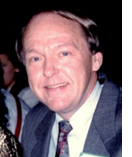
Born in Wallace, Idaho, in 1937, Jerry Knapp attended the University of Idaho where he received an M.S. Degree in Agricultural Economics in 1961. He is a member of Alpha Zeta, a scholastic honorary. Before joining CH2M HILL, he worked for the U.S. Bureau of Reclamation in Washington, D.C., the Royal Irrigation Department in Thailand, and another engineering company in Chicago, Illinois.
Jerry joined CH2M HILL in 1978 to develop the firm’s practice in resource and environmental economics to serve water agencies and utilities. In 1980, he was promoted to Vice President and firmwide Director of Economic and Financial Services. In 1988, he initiated development of a firmwide management consulting practice. In 1993, Jerry was appointed Regional Director for Russia, where he established CH2M HILL offices in Moscow, Novokuznetsk (Western Siberia), Vladivostok, and Khabarovsk (Russian Far East). He assembled teams of U.S. and Russian experts to conduct demonstration projects funded by the U.S. Agency for International Development to promote environmentally sound business opportunities, pollution prevention, legal reform, environmental education, and sustainable development.
Jerry retired in 2000 and established an in-home consulting firm. He worked part time as a consultant to CH2M HILL and others doing water resources planning and management consulting. He enjoyed his hobbies of genealogy, handyman home improvements and repairs, boating, and travel. He spent time compiling a family history and writing a book with his wife, Kullaya, about their travel adventures.
Jerry passed in January 2016, at home with his family.
Gordon Koblitz

Born in Seattle, Washington, in 1941, Gordon attended California State University at Long Beach obtaining his B.S. and M.S. Degrees in Civil Engineering in 1967 and served as President of the local Tau Beta Pi engineering honor society. Following graduation, he joined CH2M in Corvallis as a Project Engineer under the mentor “wings” of Dick Humphrey and John Filbert for the Bend and Redmond, Oregon, sewerage system studies followed by the resulting treatment plant and sewer system designs, respectively.
As a Project Manager, Gordon managed numerous wastewater treatment plant (WWTP) designs around the state and was fortunate to work with Les Wierson on the study and design of the Kihei, Maui, Hawaii, sewerage system in the early to mid 1970s. The Kihei facilities design won the Water and Wastes Engineering Magazine’s National Excellence in Design Award in 1976. Gordon moved to the PDX office in 1974 as part of the “migration” of staff from CVO to build the firm’s capability in our growing offices around the country. He became the 70s Division Manager and worked with major clients (Unified Sewerage Agency, City of Portland, and Clackamas County) while maintaining continuing roles in the Hawaii and American Samoa wastewater work.
In 1983, Gordon moved to Dallas to start a CH2M HILL presence in the State of Texas. With the support of Kent Robinson, Steve Aasheim, and others, the Dallas office developed many water and wastewater projects in the North Texas area in the ensuing years. Gordon also helped to obtain new projects in San Antonio and Austin in the mid-1980s, which led to new offices being established. Over the years, Gordon had roles as Dallas/Fort Worth Area Manager, North Texas Regional Manager, and Austin Area Manager. He was active with the Texas Water Pollution Control Association (now Water Environment Association of Texas) and served as President, Director, and several committee chair roles, and also served on the Water Environment Federation (WEF) Executive and Nominating Committees.
Gordon went to flex-time status in 2007 and retains selected client roles with the City of Austin, Upper Trinity Regional Water District, and City of Frisco, Texas. He is keeping very busy in his role as Publisher for the CH2M HILL Retiree/Alumni Newsletter and working with his retiree teammates on updating and developing the retiree/alumni websites. He and Mary enjoy extensive traveling with friends, family activities (both daughters and four grandchildren live in Texas just minutes away), Pickleball, summers in Oregon near Sisters, and keeping in touch with CH2M HILL friends. Read More.
Recollections by Gordon Koblitz
Edwin Lance
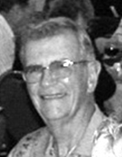
Born in Sacramento, California, in 1933, Ed Lance attended Oregon State University, graduating with a B.S. Degree in Engineering, Agricultural Engineering in 1956, and became a Commissioned Officer in the U.S. Army Corps of Engineers. He saw active service with Combat Engineers, U.S. Army from 1956 until discharged in 1958. Ed served as District Engineer and was named District Manager for the Tulelake Irrigation District, Tulelake, California, responsible for managing 67,000 acres of irrigated land.
Ed joined Clair A. Hill and Associates (CAHA) as a Project Engineer in February 1966 and served in many important Project Management positions, at times on projects shared with CH2M. Ed was a firm advocate of the merger of CAHA and CH2M and looked forward to becoming a role player in the resulting organization. As Department Manager and Discipline Group Director for Agricultural Engineering, he was involved in adding Agricultural Engineers and Scientists to meet the increasing workload brought about by the merger.
Part of the workload stemmed from a USAID contract calling for project assignments in several undeveloped countries. During the years 1989 to 1996, the Water Resources discipline was reshaped. Ed’s role was to manage a smooth transition to the Environmental and Water/Wastewater groups, a task completed in 1990. In 1985, he moved to Denver and was assigned to the Denver Region. He served a 3-year term on CH2M HILL’s Board of Directors.
In 1993, Ed moved his family back to Redding, California, and retired in 1996. He continues to serve on a part time basis as a senior reviewer on irrigation and water resource planning projects.
Frank Lanou Jr.
Frank Lanou was born in Providence, Rhode Island, in 1930. He received his B.A. Degree from the University of Tennessee in 1954 and his M.A. Degree from the Fletcher School/Tufts Harvard in 1955. Following his graduation, he worked for several major oil companies in New York, and for the H. Zinder Consultants organization working in the field of Electric Power Regulation.
H. Zinder & Associates became part of the CH2M organization in 1968. Frank joined CH2M HILL as an Economist in 1971, specializing in the Electric Utility Regulation field until his retirement. He was asked to head the Economics Department in the SEA office in 1978, a position he held until 1981, following his appointment as Director of Energy Economics in 1980.
During his career, Frank contributed much toward developing and increasing the Electric and Gas Utility Services offered by CH2M HILL nationwide and in Canada. He provided professional services to a number of major clients as well as serving as the Project Economist on the huge Milwaukee Sewer Project and the Columbia Basin Expansion Studies project.
Frank retired in 1993 but continued to serve as a consultant in private practice. A post retirement project Frank adopted is to write the history of Acadia.
Mark Lasswell
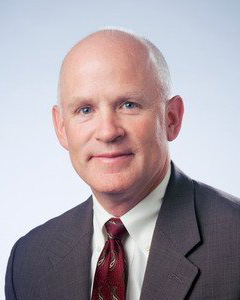 Born in Corvallis, OR, Mark Lasswell attended Oregon State University and received BSCE and MSCE Degrees. He began his career in 1977 with a NW consulting engineering company headquartered in Bend, OR. There he worked on the City’s new wastewater system, in a JV with CH2M HILL and Carollo. Mark then moved to Portland and opened a branch for the company.
Born in Corvallis, OR, Mark Lasswell attended Oregon State University and received BSCE and MSCE Degrees. He began his career in 1977 with a NW consulting engineering company headquartered in Bend, OR. There he worked on the City’s new wastewater system, in a JV with CH2M HILL and Carollo. Mark then moved to Portland and opened a branch for the company.
Mark joined CH2M HILL in 1989 in the Portland office, first as the wastewater department manager, then as division manager, and finally as the regional manager. In CH2M HILL’s mid-90s reorganization, he became the marketing and sales leader for the newly formed Water Business Group. In 2004, Mark moved to Denver and became the president of Operations Management International (OMI). Then, he became president of the new Infrastructure Group, followed by president of the Transportation Business Group, and finally president of CH2M HILL’s Alaska Business. Mark retired in 2014 and closed his career as CEO of Rain for Rent. In addition to the above roles, he led a companywide Business Development Improvement Initiative, was executive sponsor for the company’s leadership development program, and stayed engaged with clients and projects throughout his career (which was the most fun).
Mark and Kathi currently live in Belgrade, MT, near Bozeman, where he fly fishes, bird hunts, woodworks, and skis. He still consults with several companies and individual leaders, and he serves on a local nonprofit Board. Their two sons live in Oregon.
Sidney S. Lasswell
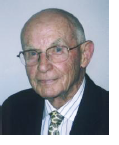
CH2M HILL Years
Sid Lasswell was born in Eugene, Oregon, on May 21, 1924. He went through high school in Portland and completed his freshman year at Oregon State College (now University) in June of 1942. After a war delay, he graduated with a B.S. Degree in Civil Engineering in 1949 with a specialization in water and wastewater. With Fred Merryfield as his prime professor, Sid was hired immediately after graduation as Employee No. 11 and began work at $265 a month as a Water/Wastewater Engineer. At that time, the firm was composed of the four named partners, Archie Rice, Ralph Roderick, Earl Reynolds, draftsman Nils Nordquist, Bob Adams, and a secretary.
Sid’s first two assignments with CH2M were as a Resident Engineer on a water project at Bingen, Washington, in 1949 and on a wastewater treatment plant at Forest Grove, Oregon, in 1950. The bids came in higher than expected on the Forest Grove plant, so the City authorized Sid to purchase and install all aboveground piping and mechanical equipment with the help of a retired fire chief. Because the contractor was union, Sid and the fire chief had to work during times the contractor was not onsite. Sid thinks of this as our first design/build effort.
Sid received his Civil Engineering license in 1951 and received a $10 per month raise. He held other licenses in California, Illinois, Colorado, and Virginia. He became one of the eventual 12 partners in 1961 and became a stockholder in 1966 when the firm incorporated.
Sid progressed through Department Manager, Division Manager, and Discipline Director of the Water/Wastewater group in 1971. As Discipline Director, Sid was responsible firmwide for the technical quality of all water and wastewater projects, including staffing, training, project coordination, and technical advancement.
During his early years, Sid either designed or was responsible for the design of most of the CH2M wastewater treatment and collection projects in Oregon. His first major project was the Salem Sewerage System project in the mid-1960s. In those days, engineering fees were still based on a “percent of construction.” When the low bids came in, Sid drove back to Corvallis leaving $100,000 of anticipated income “on the table”!
In 1974, Sid married Florence Elizabeth (Judy) Johnson. Judy was the first discipline assistant hired after the Discipline System was made a part of the CH2M HILL organization structure, as recommended by Archie Rice.
In 1975, he became firmwide Director of Technology and Senior Vice President and served in that capacity through 1988. He was also the Corvallis Regional Office Manager from 1976 through 1989. He served four terms on the CH2M HILL Board of Directors and in 1979 was a candidate for the position of President of CH2M HILL along with Jim Poirot, Les Wierson, Earl Reynolds, and Harlan Moyer.
As one of his training responsibilities as Director of Technology, Sid developed and participated in 93 presentations each lasting 2.5 days, known as the Capstone Seminars. These seminars were given in all CH2M HILL offices at least once or more from 1980 through 1993.
As the firm grew rapidly in the early 1970s, Sid became concerned that a yearly firmwide function would be valuable to help employees meet their geographically scattered peers. Because softball was a fairly common denominator in many offices, the Corvallis Office started sponsoring a regional office softball tournament in Corvallis. The participation rapidly outgrew the capacity of Corvallis, and the event was moved to Bend. At its peak in the 1980s, over 50 regional office men’s and women’s teams competed; and total attendance exceeded 1,500. The event was eventually named after Sid, but his Corvallis office teams never won the tournament. The Sid Lasswell Softball Tournament remains to this day the only effort to bring far flung employees and families together.
Over the 45 years in varying positions with CH2M HILL, Sid has traveled to over 41 countries in helping to develop international work and support project work as it developed. During this same period, he was an enthusiastic participant in causing the firm to double in staff size on the average every 4.5 years. This is actually a faster growth rate than that between 1993 and the present, although the “numbers” are bigger today.
Sid officially retired in 1990, but continued to serve as Principal-In-Charge during the last few years of the $2 billion Milwaukee Wastewater Collection and Treatment Project until 1996. Sid’s retirement from management allowed his youngest son, Mark, to join the firm.
After nearly 47 years with CH2M HILL, Sid still cannot remember a day when he did not look forward to going to work, although he will admit that some days he should have stayed in bed. Sid also remembers and respects all the great people he hired, trained, worked with, and became friends and associates with over the 45 years of his involvement with the firm!
Sid passed away on February 24, 2019. A celebration of life was held at the Oregon State University CH2M HILL Alumni Center on March 22, 2019.
(Read More) (View Sid’s 80th Birthday Celebration) (PDF) (View Sid’s 90th Birthday Celebration) (PDF)
Robert (Bob) Lathen
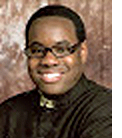
Bob Lathen was born in Clarkston, Washington. He attended Brigham Young University, graduating with a B.A. Degree in Accounting and an M.A. Degree in Tax Accounting. Prior to joining CH2M HILL, he spent 3 years with Arthur Andersen Company as a staff accountant.
Bob joined CH2M HILL in 1984 as a Senior Tax Accountant, preparing the firm’s first in house corporate tax returns in 1985. He played significant roles in performing the Iotech Building Study, thereby harvesting hundreds of thousands of dollars of tax credits and keeping CH2M HILL in compliance with the Investment Development Bond issue to finance the new Corvallis Office building.
Bob worked with Richard Corrigan to successfully convince the U.S. Congress to legislate favorable tax laws that allowed CH2M HILL to continue to use the Cash Method of Accounting. He played a management role in defending the firm during the IRS Audit of 1990-1991, which resulted from the Dingell Investigation.
After 27 years of service, Bob retired in August 2011.
John Lee
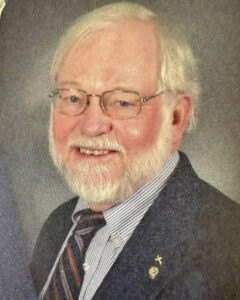 John Lee’s life began on May 26, 1940, on the White Mountain Apache reservation in Arizona. He was his parents’ first child. When the time had come, his excited father rushed 20 miles on a dirt road to the nearest hospital, ran into the waiting room announcing that his wife was having a baby, only to realize he had left her at home. A neighbor came to his mother’s rescue, however, as John chose not to delay his entrance into the world.
John Lee’s life began on May 26, 1940, on the White Mountain Apache reservation in Arizona. He was his parents’ first child. When the time had come, his excited father rushed 20 miles on a dirt road to the nearest hospital, ran into the waiting room announcing that his wife was having a baby, only to realize he had left her at home. A neighbor came to his mother’s rescue, however, as John chose not to delay his entrance into the world.
His father ran a trading post, and his mother had come to the reservation as a teacher. John attended grade school in a three-room schoolhouse in Whiteriver, where most of his classmates were Apache. In later life, John credited his productive work ethic and absolute integrity to the example of both his parents. His humble generosity was influenced by the Apache culture.
As a teenager, John spent summers working in the trading post, as a hod carrier for bricklayers, and as a cowboy on weekends and week-long cattle drives. With no accredited high school nearby, John attended Wasatch Academy, a boarding school in Mt. Pleasant, Utah, where he developed close, life-long friendships. He credited his teachers with making a profound impact on the direction and success of his career. Wasatch opened the broader world to him, and he later returned to serve the school as a dedicated trustee and benefactor.
He received a B.S. Degree in Chemical Engineering and an M.S. Degree in Environmental Engineering from Arizona State University. After college, he served as an officer in the U.S. Air Force and worked in the Athena missile testing program. After his military service, John went to work for CH2M HILL, at that time a small environmental engineering firm. He worked with the company for over 50 years in many roles from technologist to Senior Vice President, spearheading the development of solutions for industrial water pollution and hazardous waste control. He was still working as an Emeritus Consultant at the time of his passing. Three of his inventions were patented.
Bob Rosain shares that he was very fortunate to have John as his friend, boss, and mentor at CH2M HILL for his 14-year tenure there. His support, advice, and counsel were a cornerstone in his consulting engineering career.
Jay Mackie shared that about a month before John’s passing, John phoned and said he would like to stop by the house for a half hour. Well, as it happens with 50-year-old friends, the half hour stretched to 2-1/2 hours as two old engineers regaled in the times they wallowed in sewage, hazardous wastes, and other nasty stuff. Jay is so glad that John decided to stop by to see, which turned out to be the last time. “I’ll remember the visit with John for the rest of my days.” Jay recommends that we all should create opportunities to see relatives and friends that we have not seen for a long time.
For many years, John belonged to the Rotary Club and a men’s discussion group, where he cultivated many close friends. Through the Rotary, he developed and supported many international projects to improve the living conditions and education of rural communities in Latin America. His life was dedicated to service.
John was a life-long member of the Lutheran church and a deeply spiritual man. Although committed to his faith and political ideals, he was contemplative and respectful of the ideas of others. He was also an adventurer who loved skiing, golf, fly-fishing, beaches, and traveling the world with his wife, Liz. John’s generosity, love, and humor, as well as his strength of character and accomplishments, made him a strong and wonderful role model for many people.
John passed away peacefully with his wife and two daughters at his side in Bellevue, Washington, on May 31, 2024. He was 84.
Doyle Leek
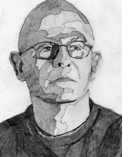
Doyle Leek was born in Klamath Falls, Oregon, in 1943. He spent most of his early years around the Ashland area. He intermittently worked in several lumber mills, rebuilt a couple of airplanes, and bounced around several Oregon schools before receiving his Associates of Engineering Degree from the Oregon Institute of Technology (OIT) in 1969.
After graduating from OIT, Doyle was hired as a draftsman in the Structural Department in the Corvallis office. He remained in Corvallis his entire career with CH2M HILL. After several years drafting, self-study, and engineering experience, he obtained his Oregon and California Civil Engineering Licenses in 1982 and, a few years later, his Oregon Structural License.
Doyle was lead structural engineer on lots of in-house projects, but mostly enjoyed working on historical projects. He designed the upgrade of several of the Oregon historic covered bridges and the rehabilitation of the Crater Lake Lodge.
After 36 years of service, Doyle retired in January 2005 and began cultivating the right side of his brain. Doyle always had an appreciation for art, and retirement gave him the opportunity to put as much effort into his second career as a watercolor painter as he did with engineering. The result has been a lot of success with the Oregon Watercolor Society, winning “Best of Show” in one show. He creates sensitive paintings that are a derivative of his precise left-brain engineering background combined with the magic inherent in the imprecise mingling and flowing of watercolors. He continues to “loosen-up” and is now getting into more shows on the west coast. He recently created a website for his paintings, www.doyleleek.com.
Doyle and his wife, Janet, still live in Corvallis where they raised their four children.
Kurt Leininger

Born in Washington, D.C., in 1944, Kurt Leininger attended Northwestern University, Evanston, Illinois, where he received his B.S. Degree in Civil Engineering in 1966, and the University of North Carolina at Chapel Hill where he graduated with his M.S. Degree in Sanitary Engineering in 1968. At Northwestern, he was elected to the Chi Epsilon Honor Society. During college, Kurt worked as a co-op student with the Illinois Sanitary Water Board in Chicago and for two Chicago-area consulting firms. In the summer of 1965 Kurt was an exchange student in the Netherlands. He worked for the firm of Kirkham Michael & Assoc. of Omaha, Nebraska, in the summer of 1966, and for Horner & Shifrin of St. Louis, Missouri, in the summer of 1968.
Kurt joined CH2M HILL in 1971 in the Reston, Virginia, office, which was to be the first of more than a dozen offices he would work in including a year in Alexandria, Egypt. Kurt served as wastewater reclamation design engineer for the majority of his career. Significant project work included the Upper Occoquan sewage collection plan in Reston, VA, and expansions of the Forest Grove and Salem, Oregon, wastewater treatment plants. Other significant work included Montgomery County (Tahoe East), MD; Jones Island wastewater treatment plant (WWTP), Milwaukee, WI; Madison (WI) Metropolitan Sewerage District; San Francisco Southeast water pollution control plan (WPCP) (sludge dewatering); San Jose/Santa Clara WPCP; Seattle Metro (sludge management studies); and the Los Angeles Program Management Office. Kurt would later assist the firm in Corvallis with quality control (QC) activities, updating master specs and the Contract Document, and assembling our design experience performance.
After his “early” retirement in 1990, Kurt went on to work for four different firms in Pennsylvania and Maryland and, as of early 2008, remains employed with BCM Engineers in Plymouth Meeting, PA.
Roger Lindquist
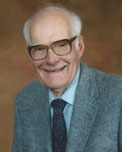
Born in Uvalde, Texas, in 1932, Roger Lindquist attended Oregon State College (OSC), where he obtained a B.S. Degree in civil engineering (1955), and the University of Minnesota, where he received an M.S. Degree in hydraulic engineering with a minor in soil mechanics (1958).
Following graduate school, Jim Howland offered Roger a job that brought him back to Corvallis, where Employee No. 24 began a career working on hundreds of interesting projects with hundreds of great people.
In his early years, Roger worked with Larry Well developing a soils laboratory in the carport at the 1600 Western Avenue office. It was here where they analyzed soil and rock samples obtained with the Acker drill rig and built and operated physical models of hydraulic structures. This early experience enabled Roger to develop several design innovations throughout his career. Some of these included working with Gary Graham on the outfall for the Menasha paper mill at North Bend, Oregon, which utilized check valves to prevent seawater and sand intrusion into outfall diffuser pipes during shutdown and under wave crest pressure (1960). Today, almost every ocean outfall and many freshwater outfalls use check valves on the outfall ports.
Again, working with Larry Well and Bob Pailthorp on the Weyerhaeuser treatment pond in Springfield, Oregon, Roger designed one of the first large (20 acres) polyvinyl chloride (PVC) liners at that time (1965). With Bill Watters and Jim Fuller on the rise of Mercer Dam, City of Dallas, Oregon, Roger modeled the first labyrinth weir in the U.S. (1972). Subsequently, CH2M HILL designed many more of these types of spillways for dams in Colorado, Reston (Virginia), Trinidad, and the West Indies. Today, these weirs are a common design feature for spillway entrances.
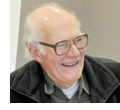
In the mid-1980s, Roger and his wife Whitney decided they did not want to wait until he was 65 to start enjoying travel, so they began to travel (mostly to Europe) each September. In the mid 1990s, he became a flex hourly employee and continued to work about 40 hours per week. Their favorite vacation was walking in the Swiss Alps where he and Whitney spent many Septembers, each followed by a visit with his brother, who lives in Vienna, Austria.
After 55 years of service, Roger retired in 2011. He died on February 27, 2017, of cancer at home in Corvallis.
(Read More) (Roger’s Career of a Lifetime)
Willie Loud
 Willie T. Loud was born in Castor, Louisiana. The family soon moved to his childhood home of Winfield, Kansas.
Willie T. Loud was born in Castor, Louisiana. The family soon moved to his childhood home of Winfield, Kansas.
Willie attended the University of Washington and received a bachelor’s degree in urban and regional planning. He completed 2 years of master’s courses in public administration and urban planning as well. Willie joined CH2M HILL in 1972 in Seattle. In 1976, he transferred to the Corvallis office and then again in 1981 to the Denver office. His initial assignments were on projects involving planning and community outreach, with an emphasis on business diversity plan development.
Over time, he became an executive in Human Resources and Government Affairs. In all, Willie’s career with the firm spanned more than 30 years of increasingly responsible roles. He dedicated his efforts to making a positive difference in the employee-owned firm to which he gave so much, and to the world at large. According to Director and Senior Vice President Bob Chapman, “Willie played a pivotal role in helping the company embrace societal and corporate changes successfully. He was also a delightful guy to work with.’
Willie held many positions with professional and civic organizations, including the American Water Works Association, Water Environment Federation, National Forum for Black Public Administrators, National Association of Minority Engineering Program Administrators, Bethany College, and the Rocky Mountain Synod of the Evangelical Lutheran Church in America.
Willie retired in 2004.
Willie passed away on December 2, 2021.
Richard (Rick) Luebbers
 On a cold, snowy day in March 1949, Rick Luebbers’ parents had to wait for the snowplow to clear the road to Osmond, Nebraska, where Rick was born at St. Joseph’s Hospital. He is the second oldest of 10 children and grew up on the family farm where he worked the fields, raised animals, and milked way too many cows. After graduating from Osmond High School as class president in 1967, Rick attended the University of Nebraska where he earned his B.S. Degree in Civil Engineering in 1971. In 1974, he earned his M.S. Degree in Transportation Engineering from Oregon State University. Rick received his first Professional Engineering license in 1975.
On a cold, snowy day in March 1949, Rick Luebbers’ parents had to wait for the snowplow to clear the road to Osmond, Nebraska, where Rick was born at St. Joseph’s Hospital. He is the second oldest of 10 children and grew up on the family farm where he worked the fields, raised animals, and milked way too many cows. After graduating from Osmond High School as class president in 1967, Rick attended the University of Nebraska where he earned his B.S. Degree in Civil Engineering in 1971. In 1974, he earned his M.S. Degree in Transportation Engineering from Oregon State University. Rick received his first Professional Engineering license in 1975.
During college summers, Rick worked on highway construction projects, starting as a laborer and eventually becoming an equipment operator. He especially liked operating the big earthmoving scrapers. Along the way, Rick married Sandy; and they lived in Lincoln, Nebraska, during college. Following graduation, Rick and Sandy packed up the 1967 GTO and traveled to Anacortes, Washington, for a job as Plant Engineer for the Texaco refinery. During the 2 years there, Rick worked with Mike Harris, Mike Sailor, and Jim Black (all of whom later joined CH2M HILL). Both Mikes left Texaco and went to Oregon State University in Corvallis, Oregon. Mike Harris invited Rick to come for a visit where he showed Rick around OSU and the local consulting firm, CH2M HILL. Mike encouraged Rick to apply to both places. And within 6 months, Rick was enrolled in grad school at OSU and working part time at CH2M HILL for Vaughn Sterling’s transportation group.
After graduation, Rick worked in the CVO office for 4 years on a variety of site civil, traffic, and airport projects. In 1977, he relocated to Kansas City, Missouri, for a 2-year project at Kansas City International Airport. Following that, he moved to the San Francisco Bay Area to launch CH2M HILL’s transportation work in the SFO office. In the next 3 years, Rick provided transportation planning services, designed traffic signals, and helped win and deliver a large railroad grade separation project in South San Francisco. In 1982, Rick, Sandy, and their son moved to Sacramento to continue the growth of CH2M HILL’s transportation program in California. Within the next 8 years, CH2M HILL was providing transportation consulting services from Redding to San Diego. During this time, Rick worked on a variety of projects, including the expansion of John Wayne Airport in Santa Ana, on the planning of large freeways in the Central Valley, and on many freeway interchanges and railroad grade separation projects throughout the state. He was also involved in CH2M HILL’s work in the design of new prisons throughout the state.
In 1990, Rick moved back to the CVO office where he joined with the transportation teams throughout the Northwest to transform the old discipline system into the new Transportation Business Group. Over the next 10 years, he wrote proposals, managed projects, and hired and trained staff throughout the Northwest Region. For the last 7 years, Rick led the NWT business development program, which was successful in winning projects in Oregon, Washington, Idaho, Montana, Alaska, and Hawaii and tripling the volume of the region’s transportation business.
Shortly after 2000, Rick moved to Denver to work with the Transportation Business Group’s program to expand consulting services across the U.S. and overseas, and to begin work on design-build projects. This led to assignments in West Palm Beach, Florida; Vancouver and Toronto, Canada; United Arab Emirates; Salt Lake City, Utah; and Southern California. His final assignment was providing program management services for the design and construction of a visionary new structure to replace the historic Sixth Street Viaduct in Los Angeles, CA.
Upon retiring in 2014, after 41 years with CH2M HILL, Rick returned to the Northwest to live on Whidbey Island’s Mutiny Bay. In addition to building a new garage, restoring a remote yurt, hunting moose in Alaska, and fishing for king salmon in Puget Sound, he attends the College Baseball World Series in Omaha each summer. Rick led the planning efforts for CH2M HILL’s 2015 and 2016 Alumni Reunions. He has since served as an advisor to the teams for the 2018 and 2021 reunions. He has been the Master of Ceremonies for recent alumni reunions and has participated in the CH2M HILL Alumni History group’s activities. Rick was part of the alumni group that successfully led the proxy vote to place a retiree on the CH2M HILL Board of Directors just before the firm’s acquisition by Jacobs Engineering. Rick currently serves on the CH2M HILL Alumni Association (CHAA) Board of Directors where he led the Nominating Committee for 2020 and the development of the CHAA Strategic Plan for 2021.
